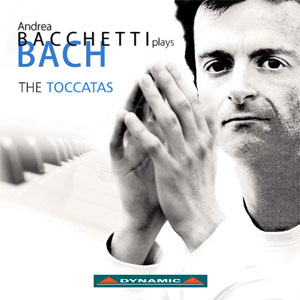

Classical Editor: Rob Barnett
Founder: Len Mullenger
REVIEW - June 10th, 2010 read more: Dominy Clements, July 10th, 2010
 Johann Sebastian BACH
(1685-1750)
Johann Sebastian BACH
(1685-1750)Toccata in G Major BWV 916 [7:13]
Toccata in E minor BWV 914 [8:43]
Toccata in D minor BWV 913 - earlier version [16:10]
Toccata in G minor BWV 915 [10:29]
Toccata in D Major BWV 912 - later version [14:38]
Toccata in F sharp minor BWV 910 [9:12]
Toccata in C minor BWV 911 [12:21]
● Andrea Bacchetti (piano)
rec. Fazioli Concert Hall of Sacile, Italy
13 October 2009-12 January 2010
Stereo. DDD.
● DYNAMIC CDS 658 [79:43] F
There was once a time that piano
recordings of the Bach Toccatas, like those of the Goldberg Variations,
fell into two categories: Glenn Gould and not Glenn Gould. A younger
generation of pianists now seems intent on changing all that, integrating
elements of Gould's Bach without necessarily falling under the shadow of
his larger-than-life musical persona.
Andrea Bacchetti's decision to record the Toccatas is itself instructive,
these being works long dominated in the catalogue by the Gould recordings.
Bacchetti already has highly regarded recordings of the English Suites,
Two-Part Inventions and Sinfonias under his belt, which clearly demonstrate
he is his own man.
The relative neglect of the Toccatas is difficult to explain. They are early
works, from the composer's Weimar period, but then most of Bach's keyboard
music predates his move to Leipzig. They are somewhat lacking in contrapuntal
ingenuity, although BWV 913, 914 and 915 each ends in an impressive fugue.
They also lack the stylistic variety of the suites, although they more than
make up for this in textural diversity.
Bacchetti avoids extremes in his interpretations. The performance style
favours smooth legato, reserved ornamentation and an even balance between
the hands. He is rarely tempted to emphasise fugal subjects or thematically
significant bass lines. His touch is delicate rather than muscular; everything
is confident and decisive but nothing is emphatic or overstated.
Little surprise, then that the greatest interpretive distance between Bacchetti
and Gould is in the louder and faster movements. Compare, for example, their
readings of the final fugue of BWV 914. Where Gould is fast and angular,
Bacchetti is even and lyrical. He is not as heavy on the left hand as his
predecessor either, so you have to listen all the more closely to pick out
the counterpoint. But Bacchetti shapes the movement in a way that would probably
be of little interest to Gould. He gradually builds up to the recapitulation,
but even when he reaches it, there is little sense of exaltation, as he maintains
a sense of control and balance to the very end. In a way, this approach is just
as impressive as Gould's fireworks, even if it doesn't grab the attention in
quite the same way.
Gould's legacy is much clearer in the adagios. Both pianists share a desire
for the piano to sing, although Bacchetti refrains from any Gould-like
vocalisations of his own. The closest the two men come is in the Adagio of
BWV 911, where Bacchetti creates a luminous inner beauty in the sound of each
of the piano chords. It is all a little faster and more foursquare than you
would expect from Gould, but it is clearly in his spirit.
The recorded sound is good, although not particularly crisp. This may be
deliberate, an attempt to complement the rounded, legato style of the pianist
with a warm sound profile. It all adds up to an attractive offering, nothing
extreme but a performance with clear artistic focus, and based on a desire to
find beauty in every element of the music. After the rapturous reception that
greeted Bacchetti's previous Bach recording, he is clearly not resting on his
laurels.
Gavin Dixon